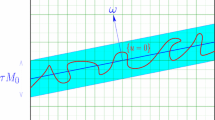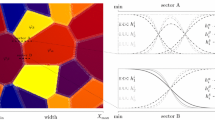Abstract
First we recognize that the coherence of certain phase transformations in solids is most vividly expressed using the material manifold and within the kinematic continuum description based on the so-calledinverse motion. In this fully dynamical framework the equation of interest is theun-balance of pseudomomentum for thermoelastic conductors. On computing the power developed by the accompanying surface source of quasi-inhomogeneities at the phase-transition front, we show that this relates directly to the normal jump of the Eshelby stress — devoid of any kinetic energy, but computed from the free energy — a scalar quantity which may be referred to as theHugoniot-Gibbs configurational force at the front. The thermodynamic analysis also establishes that this power is dissipated as the material progresses at the front that ishomothermal. The jump relation including this dissipation is that associated with the heat propagation equation valid at regular points. In all, this approach is based on the theory of material uniformity and inhomogeneities as developed in recent years by M. Epstein and the authors. All reasonings are made in full dynamics, for finite strains, and any anisotropy in three dimensions.
Sommario
Si osserva preliminarmente che, per alcune trasformazioni di fase nei solidi, la più naturale descrizione del fenomeno nell'ambito del continuo sembra essere quella basata sul moto inverse in dinamica, o sulla deformazione inversa in statica. In tale quadro, la nozione di ‘coerenza di fase’, suggerita dalla congruenza geometricocinematica tra due distinti reticoli cristallini a contatto, trova la sua espressione più significativa nella condizione di continuità degli ‘spostamenti di siti’ nel riferimento cristalline. Sulla base di argomentazioni svolte in precedenti lavori dagli autori per il caso dinamico e da M. Epstein per il caso statico e termostatico, si presuppone valida un'equazione di bilancio ‘materiale’: quella dellapseudo-quantità di moto. Si richiede che tale bilancio sia soddisfatto attraverso una superficie di contatto tra le due fasi. Tale superficie o fronte, avanzando, determina la trasformazione del materiale da una fase nell'altra. Il fronte è suppostoomotermo ed il materiale termoelastico in ciascuna delle due fasi. Un ruolo chiave è svolto dal tensore degli sforzi materiali di Eshelby. Infatti, la potenza sviluppata dalle forze di disomogeneità attraverso il fronte che avanza è unicamente determinata dalla discontinuità del tensore di Eshelby lungo la normale al fronte. Inoltre, l'espressione che detta potenza assume permette di evidenziare una quantità scalare che proponiamo di denominareforza configurazionale di Hugoniot-Gibbs per le analogie che essa suggerisce. Si sviluppa infine una trattazione parallela sulla base di una formulazione termodinamica classica del continuo. Un confronto dei risultati permette di Stabilire che la potenza sviluppata dalla forza configurazionale viene dissipata mentre il fronte avanza.
Similar content being viewed by others
References
Bruhat, G.,Thermodynamique, Masson Editeurs, Paris, 1962.
Bain, E.C.,Trans. Amer. Inst. Min. Metall. Eng.,70 (1924) 25–41.
Roitburd, A.L., ‘Equilibrium and phase diagrams of coherent phases in solids’,Sov. Phys. Solid State,26 (1984) 1229–1233.
Cahn, J.W. and Larché, F.L., ‘A simple model for coherent equilibrium’,Acta Metall.,32 (1984) 1915–1923.
Buerger, M.J.,Phase Transformations in Solids, J. Wiley, New York, 1951.
Bitter, F., ‘On impurities in metals’,Phys. Rev.,37 (1931) 1527–1547.
Maugin, G.A.,Material Inhomogeneities in Elasticity, Chapman and Hall, London, 1993.
Maugin, G.A. and Trimarco, C., ‘Pseudo-quantité de mouvement et milieux élastiques inhomogènes’,C.R. Acad. Sci. Paris,II-316 (1991) 851–856.
Maugin, G.A. and Trimarco, C., ‘Pseudomomentum and material forces in nonlinear elasticity: variational formulations and applications to brittle fracture’,Acta Mechanica,94 (1992) 1–28.
Maugin, G.A. and Trimarco, C., ‘Note on a mixed variational principle in finite elasticity’,Rend. Mat. Accad. Lincei,9 (1992) 69–74.
Abeyaratne, R. and Knowles, J.K., ‘On the driving traction acting on a surface of strain-discontinuity in a continuum’,J. Mech. Phys. Solids,38 (1990) 345–360.
Roitburd, A.L., ‘Martensitic transformation as a typical phase transition in solids’ in:Solid State Physics, Vol. 33, Academic Press, New York, 1978 pp. 317–407.
Kröner, E., ‘Differential geometry of defects in condensed systems’,Int.J.Engng. Sci.,19 (1982) 1507–1515.
Epstein, M. and Maugin, G.A., ‘The energy-momentum tensor and material uniformity in finite elasticity’,Acta Mechanica,83 (1990) 127–13.
Epstein, M. and Maugin, G.A., ‘On the geometrical material structure of anelasticity’ (Preprint UPMC-LMM, Paris, July 1994).Acta Mechanica (in print, 1995).
Truesdell, C.A. and Noll, W., ‘The nonlinear field theory of mechanics’, in:Handbuch der Physik, Bd. III/3, ed. S. Flügge, Springer-Verlag, Berlin, 1965.
Kosinski, W.,Field Singularities and Wave Analysis in Continuum Mechanics, P.A.N., Warsaw and Ellis-Horwood, Chichester, U.K., 1986.
Suhubi, E.S., ‘Thermoelastic solids’, in:Continuum Physics, Vol. 2, ed. A.C. Eringen, Academic Press, New York, (1975) pp. 174–265.
Maugin, G.A.,Continuum Mechanics of Electromagnetic Solids, North-Holland, Amsterdam, 1988.
Maugin, G.A.,The Thermomechanics of Plasticity and Fracture, Cambridge University Press, U.K., 1992.
Epstein, M. and Maugin, G.A., ‘Thermoelastic material forces: definition and geometric aspects’,C.R. Acad. Sci. Paris. II-320, (1995), 63–68.
Bui, H.D.,Mécanique de la Rupture Fragile, Masson Editeurs, Paris.
Maugin, G.A. and Trimarco, C., ‘Dissipation of configurational forces in defective elastic bodies’,Arch. Mech. 47, (1995), 81–99.
Hill, R., ‘Energy-momentum tensor in elastostatics: some reflections on the general theory’,J. Mech. Phys. Solids,34 (1986) 305–317.
Eshelby, J.D., ‘Energy relations and the energy-momentum tensor in continuum mechanics’, in:Inelastic Behavior of Solids, eds. M.F. McKinnen, W.F. Adler, A.R. Rosenfeld and R.I. Jaffe, McGraw Hill, New York 1970, pp. 77–114.
Dems, K. and Mroz, Z., ‘Stability conditions for brittle-plastic structures with propagation damage surfaces’,J. Struct. Mech.,13 (1985) 95–122.
Pradeil-Duval, R.M. and Stolz, C., ‘Sur le problème d'évolution des solides avec changement de phase irréversible’,C.R. Acad. Sci. Paris,II-313 (1991) 297–302.
Bowen R.M., ‘Towards a thermodynamics and mechanics of mixture’,Arch. art. Mech. Anal.,24 (1967) 370–403.
Grinfeld, M.A.,Thermodynamic Methods in the Theory of Heterogeneous Systems, ISIMM Series, Longman, Harlow, U.K., 1991.
Truskinowski L.M., ‘Dynamics of non-equilibrium phase boundaries in a heat-conducting nonlinearly elastic medium’,P.M.M. (J. App. Math. Mech., USSR),51 (1987) 777–784.
Dascalu, C. and Maugin, G.A., ‘The energy of elastic defects: a distributional approach’,Proc. R. Soc. Lond.,A445 (1994) 23–37.
Maugin, G.A., ‘The principle of virtual power in continuum mechanics: application to coupled fields’,Acta Mechanica,35 (1980) 1–70.
Maugin, G.A., Pouget, J., Drouot, R. and Collet, B.,Nonlinear Electromechanical Couplings, J. Wiley, New York, 1992.
Ericksen, J.L.,Introduction to the Thermodynamics of Solids, Chapman and Hall, London, 1991.
Stolz, C., ‘Sur le problème d'évolution thermomécanique des solides à changement brutal de caractéristiques’,C.R. Acad. Sci. Paris,II-318 (1994) 1425–1428.
Gurtin, M.E., ‘The dynamics of solid-solid phase transitions, I. Coherent interfaces’,Arch. Rat. Mech. Anal.,123 (1993) 305–335.
Maugin, G.A. and Trimarco, C. ‘Configurational forces and coherent phase transitions in electromagnetothermoelastic solids’ (in preparation, 1995).
Author information
Authors and Affiliations
Rights and permissions
About this article
Cite this article
Maugin, G.A., Trimarco, C. The dynamics of configurational forces at phase-transition fronts. Meccanica 30, 605–619 (1995). https://doi.org/10.1007/BF01557088
Received:
Accepted:
Issue Date:
DOI: https://doi.org/10.1007/BF01557088




